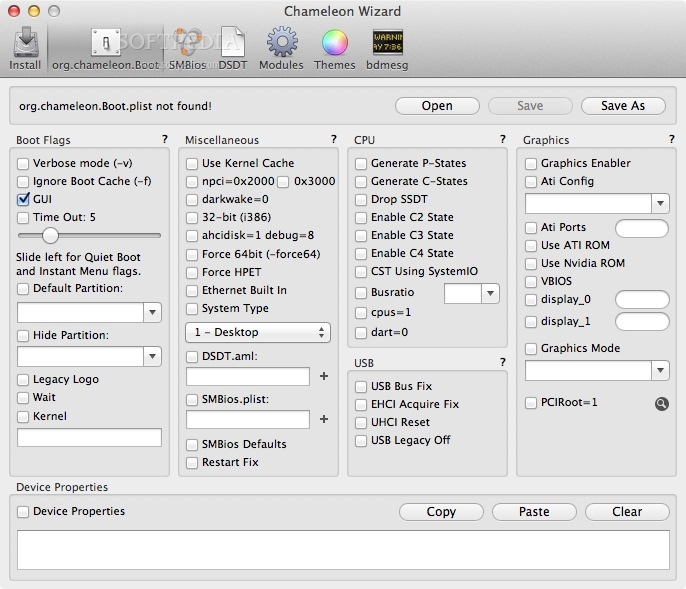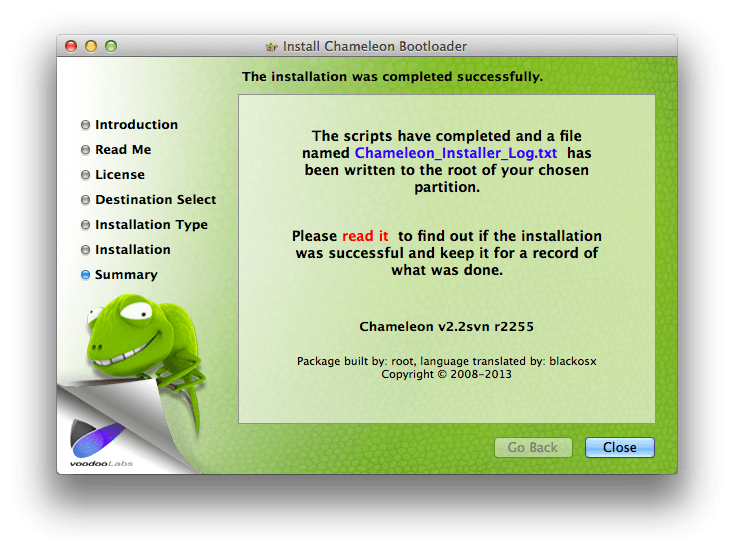Download Chameleon Wizard Mavericks

OS X Install Mavericks 13A603.torrent.zip Chameleon-2.2svn-r2255 1604-Kext Wizard.zip Download MultiBeast Mavericks Edition from tonymacx86.com Extra v2.0.zip Extra for DELL Inspiron 5520 v2.0.zip. OS X Mavericks Single System Installation. Before installation you need have an existing Mac or Hackintosh with Mac OS X to run some program. This site uses cookies to help personalise content, tailor your experience and to keep you logged in if you register. By continuing to use this site, you are consenting to our use of cookies. Hackintosh - Como Aplicar Temas Chimera/Chameleon com Chameleon Wizard - Duration: 2:46.
Tekken blood vengeance online. Not only can you download from youtube HD copies of your movies and music, you can also download the mobile 3GP version for your mobile devices plus the standard MP4 and FLV format. Just enter your video URL below, and KeepHD will automatically grab each version of the youtube video clip you want to download. ABOUT KEEPHD KeepHD is a sweet tool that lets you download HD videos off Youtube and other tube sites in to your video editing software!
Wizards Vs Mavericks

Chameleon Download
Similar Content
- By fusion71auThis is a brief guide on how to create a vanilla El Capitan (also same process for Sierra) OS X Installer USB with an updated prelinked kernel containing FakeSMC.
It is tailored for those users who want to understand the “nuts and bolts” of how to create an installer and also to help brush up on their terminal skills (rather than have one made for them with the numerous automated “tools” available or even Apple’s createinstallmedia) :
Specifically, it is also a “Proof of Concept” which shows that installation is possible without even having to rely on boot loader kext injection.
Prerequisites
Existing Yosemite installation (or Mavericks - see post#4 for steps 7,8) “Install OS X El Capitan.app' downloaded to the Applications folder Pacifist FakeSMC.kext - Slice or Kozlek branch Bootloader - Clover or Chameleon 8GB or larger USB drive (16GB recommended), formatted HFS+ (MBR or GUID) named “Installer”
Procedure
1. Boot into Yosemite with the kext-dev-mode=1 boot flag
2. Open OS X terminal and type the following lines, followed by <Enter> after each line.
The image restore and file copying may take a while to complete, and at the end of the process, the Installer volume is renamed to “OS X Base System'..
sudo -shdiutil attach /Applications/Install OS X El Capitan.app/Contents/SharedSupport/InstallESD.dmgasr restore -source /Volumes/OS X Install ESD/BaseSystem.dmg -target /Volumes/Installer -erase -format HFS+ -noprompt -noverifyrm /Volumes/OS X Base System/System/Installation/Packagescp -av /Volumes/OS X Install ESD/Packages /Volumes/OS X Base System/System/Installationcp -av /Volumes/OS X Install ESD/BaseSystem.dmg /Volumes/OS X Install ESD/BaseSystem.chunklist /Volumes/OS X Base Systemdiskutil unmount /Volumes/OS X Install ESDexit 3. Right click on the “OS X Base System” Volume and click “Get Info”
4. Click on the lock icon and untick “Ignore ownership on this volume”
5. Extract/Copy the El Capitan Kernels folder into /System/Library/ of the USB with Pacifist. NB It is found in the 'Essentials.pkg' in /System/Installation/Packages
6. Delete or Rename the original /System/Library/PrelinkedKernels/prelinkedkernel —> OG.prelinkedkernel
7. Copy FakeSMC.kext and other necessary kexts (e.g. VoodooPS2Controller.kext for laptops) into the /Library/Extensions folder of the installer USB using Finder.
8. Back in terminal, type the following lines, followed by <Enter> after each line to rebuild the prelinkedkernel….
sudo -schmod -R 755 /Volumes/OS X Base System/Library/Extensionschown -R 0:0 /Volumes/OS X Base System/Library/Extensionstouch /Volumes/OS X Base System/System/Library/Extensionskextcache -u /Volumes/OS X Base Systemexit Any errors should be noted but the output below is normal e.g.
9. Install your Bootloader targeting the OS X Base System volume
10. Boot your system with the USB without injected kexts into the OS X Installer GUI..
Post Install
The original prelinked kernel in a fresh install of El Capitan will also lack FakeSMC ie it will only be linked to Apple signed kexts. In order to boot into El Capitan the first time around without boot loader kext injection, the PLK needs to be rebuilt for the El Capitan volume like we did for the installer:
1. Boot into Yosemite with the kext-dev-mode=1 boot flag
2. Delete or Rename the original /System/Library/PrelinkedKernels/prelinkedkernel for the El Capitan volume —> OG.prelinkedkernel
3. Copy FakeSMC.kext and other necessary kexts (e.g. VoodooPS2Controller.kext for laptops) into the /Library/Extensions folder of El Capitan using Finder
4. Back in terminal, type the following lines, followed by <Enter> after each line to rebuild the prelinkedkernel. In this example, the El Capitan volume is named 'El_Capitan' - change if you have named it something else..
sudo -schmod -R 755 /Volumes/El_Capitan/Library/Extensionschown -R 0:0 /Volumes/El_Capitan/Library/Extensionstouch /Volumes/El_Capitan/System/Library/Extensionskextcache -u /Volumes/El_Capitanexit 5. Install your Bootloader targeting the El Capitan volume. This step is only necessary if you are installing El Capitan on a new drive without existing boot loader (not required if installing on a disk with existing boot loader beside Yosemite).
6. Reboot your system without injected kexts into El Capitan!
Other links
The All-In-One Guide to Vanilla OS X for beginners
Updates for Sierra and High Sierra Custom Prelinkedkernel Generator Tool I have made a custom prelinkedkernel generator 'PLK.tool' for Sierra + El Capitan. Instructions: 1. Download and extract the attached BaseSystem_PLK.tool.zip into your ~/Downloads folder. 2. Copy any extra kexts necessary for booting your hack to ~/Downloads/BaseSystem/ExtraKexts (e.g. FakeSMC, VoodooPS2Controller), making sure SIP is disabled. 3. Copy BaseSystem.dmg to ~/Downloads/BaseSystem 4. Open terminal and run the following commands.. cd ~/Downloads/BaseSystemchmod +x PLK.tool./PLK.tool ---> supply your admin password ---> will place your new custom prelinkedkernel on the desktop. macOS High Sierra bypass Firmware and MBR checks in post#13.
BaseSystem_PLK.tool_ElCap.zip
BaseSystem_PLK.tool_Sierra.zip
BaseSystem_PLK.tool_Mojave.zip (need to run in Mojave to avoid dependency errors)
BaseSystem_PLK.tool_Catalina.zip - By kylonCloud Clover Editor is an open source application that allows you to manage various Hackintosh Bootloaders configs everywhere.
Open Cloud Clover Editor
Cloud Clover Editor Wiki
Cloud Clover Editor Sources
Features
Supports Clover EFI, Ozmosis, Chameleon, OpenCore GUI and Text Editor Mode CCE Bank Mobile friendly
Officially supported browsers
Chrome 42+ Microsoft Edge 14+ Firefox 39+ Safari 10+ Opera 29+ Opera Mobile 12+ Chrome for Android 75+ Firefox for Android 67+
Credits
mackie100 - took some ideas from his app Clover EFI dev team Eric Slivka - new serial number Virtual1 - new serial number cecekpawon - PHP 5.3.3 patch, , help with the ACPI Loader Mode flag and more Micky1979 - Clover flying editor (Discontinued) crusher. - Help with the ACPI Loader Mode flag Download-Fritz - Help with the ACPI Loader Mode flag Pavo - Ozmosis fields and values stehor - Ozmosis fields and values Sherlocks - General help and support gujiangjiang - General help and support
Please let me know if i forgot you! - By fighttobyI have tried to install clover via no UEFI legacy mode (and with UEFI method) using the method here (http://www.tonymacx86.com/yosemite-desktop-guides/144426-how-install-os-x-yosemite-using-clover.html)
both times I can get to just past the clover boot screen and it freezes after that.
I have verbose (-v) selected in boot options: On the non-UEFI install then it hangs on:
'Waiting on <dict><key>IOProviderClass</key>..'
I have had a lot of issues with trying to get the installer working and many different things that had to be disabled but now it just gets to here and stops. Some times it will glitch out on this screen and give me a the circle with the line through it and text garbage around it where the text in the pictures are.
Need help please.
This is the laptop im using the specs are the same nothing has changed.
https://www.asus.com/Laptops/ASUS_VivoBook_X202E/
config.plist - By ciriousjokerTLDR:
I'm trying to boot MacOS on a Chromebook without UEFI. I'm stuck at getting the bootloader (Chameleon/Clover) to work.
My setup / context:
I have an Acer Chromebook Spin 13.
Available ports:
2 x USB-C 1 x USB-A 3.0 MicroSD Slot No USB A 2.0 (I've read that Clover has problems with USB 3.0) Firmware:
There's no UEFI firmware available and by default, it doesn't even allow booting anything other than ChromeOS. Thanks to MrChromebox (big shoutouts!), I flashed a custom legacy bios that allows me to boot anything linux related. This bios is flashed into the RW_LEGACY section of the existing bootloader (coreboot afaik) and doesn't have any configuration options. If I have to change a setting, I could try compiling his bios payload myself with the specific setting enabled.
What I've tried so far:
Chameleon attempts:
Only selected setting was 'Install chameleon on the chosen path', rest was unselected.
1 - Install chameleon first without restoring the basesystem:
Output:
> boot0: GPT
> boot0: done
(hangs; pressing power button once shuts down
Chameleon installation log is attached as 'Chameleon_Installer_Log_BEFORE'.
2 - Install Chameleon after restoring the base system:
Output:
> boot0: GPT
> boot0: GPT
> boot0: doneboot1: /boot <- Exactly like that, no line break in between
(hangs; pressing power button once shuts down)
I haven't been able to reproduce #2 after wiping the drive and doing the same thing again. Subsequent attempts have resulted in either #1 of either Chameleon or Clover.
Chameleon installation log is attached as 'Chameleon_Installer_Log_AFTER'.
Clover attempts:
I tried multiple settings and configurations, but all of them boiled down to either one of these.
1 - Doesn't do anything, just hangs at 'Booting from usb..'
2 - Boots into the blue/grey mode as shown in the attached images.
According to MrChromebox, this could be an old Tianocore DUET It doesn't detect anything (cpu frequency, ram, partitions or disks)
I've read pretty much every article, github readme and other types of documentation for coreboot, tianocore, clover, chameleon and MrChromebox' rw_legacy payloads and right now, I'm totally clueless as to what to try next..
A few questions that came up:
Why does chameleon hang? What is it looking for, /boot was clearly written to the disk by the Chameleon installer? What exactly is the blue/grey image? According to MrChromebox, it could be Tianocore DUET Where does it come from? Clover? The mainboard itself? Why does the blue/grey thing not detect my processor frequency or any partitions/drives? Can I use some sort of DUET bootloader to chainload Clover?
If you guys could answer any of them or if you have any other guesses or information as to what's happening, I'd be really happy!
Chameleon_Installer_Log_BEFORE.txt
Chameleon_Installer_Log_AFTER.txt - By grisnoHi people,
This is a preliminary installer to activate the Combo Mini PCIe Atheros QCWB335 in MacOS.
I want to thank the whole community for their efforts and content provided, because without these it would not be possible to create this installer.
I would appreciate comments and suggestions!!
Status:
AIRPORT : OK Atheros QCWB335 (AR9565) (168c:0036) Mini PCIe *BLUETOOTH : OK Atheros AR3012 (0cf3:3121) USB 2.0 **AIRDROP : Not TestedHANDOFF : Not TestedCONTINUITY : Not TestedWOL : Not TestedIMESSAGE : OKFACETIME : OKICLOUD : OKAPPSTORE : OK Known Issues:
- Partial support with a maximum speed of 10Mbits (10.11.0+) *
- Don't support Bluetooth Power Off/On by Software (10.10.0+) **
- Sometimes Lost Bluetooth After Sleep WakeUp (10.10.0+) **
Sources:
Insanelymac
Comments are closed.